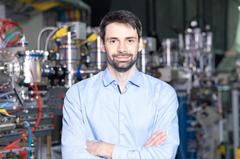URL: https://www.desy.de/news/news_search/index_eng.html
Breadcrumb Navigation
DESY News: DESY scientist wins the junior scientist contest “Talents for Fusion”
News
News from the DESY research centre
DESY scientist wins the junior scientist contest “Talents for Fusion”
Marcus Seidel, team leader at DESY and the Helmholtz Institute Jena, is one of six winners of the “Fusion Talents” competition for young researchers announced by the German Federal Ministry of Education and Research in 2024. His proposed project ‘Incoherent-drive Gas Nonlinear Optics with Yb:YLF Lasers at Cryogenic Temperatures’, IGNYTe for short, impressed the jury of internationally renowned scientists in the field of nuclear fusion research. As a result, the Federal Ministry will fund IGNYTe over the next five years, enabling Marcus Seidel to build a scientific team and conduct fundamental research in the field of laser technology, which is expected to pave the way for the development of inertial fusion power plants.

DESY researcher Marcus Seidel heads the IGNYTe project. Photo: DESY, Marta Mayer
The Fusion 2040 funding programme marks the beginning of a new era of nuclear fusion research in Germany: in addition to the magnetic confinement fusion research conducted to date, research into laser-based inertial confinement fusion is now also being funded. While in the former approach, a plasma is confined by strong magnetic fields, in the latter approach, high-energy laser pulses compress small capsules to sun-like conditions that enable hydrogen fusion. In December 2022, a breakthrough in laser fusion was achieved at the National Ignition Facility in Livermore, California: for the first time, the (kinetic) energy generated by the conversion of light hydrogen to heavier helium exceeded the (optical laser) energy that initiated the fusion process.
However, this energy surplus only refers to the directly irradiated laser energy and neglects the energy consumption of the entire driver system. For a fusion power plant, however, the balance between incoming electrical power, which is necessary, for example, to operate the lasers or cooling systems, and outgoing electrical power is crucial. In order to achieve a positive overall balance, there are still a number of physical and technical challenges to overcome, and maximising the efficiency of many process steps plays a key role in this.
IGNYTe will conduct pioneering research in this direction. On the one hand, laser technology developed at DESY by the team of Franz Kärtner and Mikhail Pergament will be investigated with respect to its suitability as an inertial confinement fusion driver. Several fundamental properties of the laser material are ideal for operating efficient high-energy lasers. The aim now is to demonstrate that these advantages can be exploited in practice and that the radiation generated can be shaped in such a way as to enable the complex hydrogen compression processes necessary to initiate nuclear fusion.
The compression of the fusion target itself can also be made significantly more efficient than in the case of the successful experiments at the National Ignition Facility. Here, the power of the laser beam was only indirectly transferred to the capsule containing the fusion fuel. This indirect approach means that only around 10 percent of the laser radiation can be used effectively to initiate nuclear fusion. Direct compression using laser radiation, on the other hand, enables coupling efficiencies of 60 to 70 percent. However, this decisive advantage is not easy to achieve, because interactions between the intense laser radiation and the resulting plasma mean that the temperatures and hydrogen densities required for nuclear fusion cannot be reached. In order to avoid such destructive interactions, the aim is to utilise the inertia of the plasma.
To do this, the properties of the laser radiation must be changed during irradiation, before resonant oscillations arise in the fusion plasma that hinder heating. For such rapid changes in radiation properties, the laser light must have a large spectral bandwidth. Moreover, ultraviolet radiation is required for effective coupling of the radiation to the fusion target. IGNYTe aims to develop an efficient and robust concept for generating the high-energy, broadband ultraviolet radiation required for this purpose. The multipass cells developed in recent years at DESY, among others by project manager Marcus Seidel, which are used for the low-loss generation of broadband radiation, are thus gaining new applications in fusion laser technology.
Scientists from DESY and partners from the Laboratory for Laser Energetics in Rochester, New York, the Centre for Physical Sciences and Technology in Vilnius, Lithuania, and the Hamburg start-up company n2-Photonics are participating in the IGNYTe project, which is now starting.



